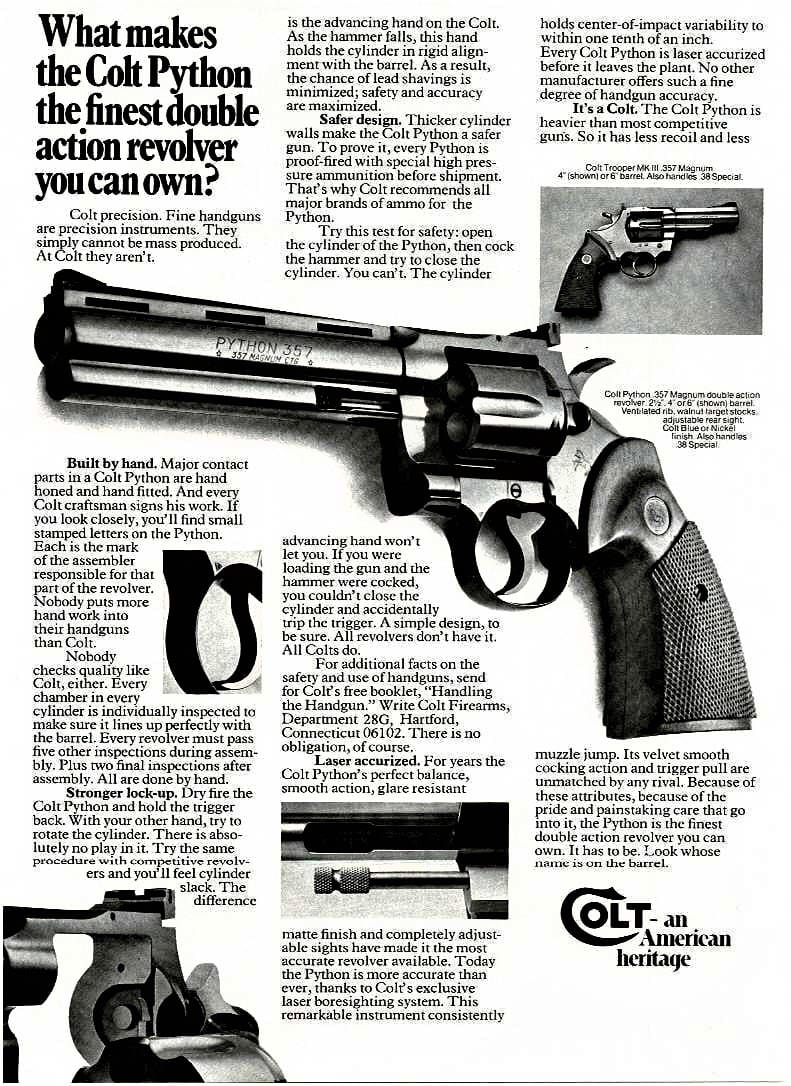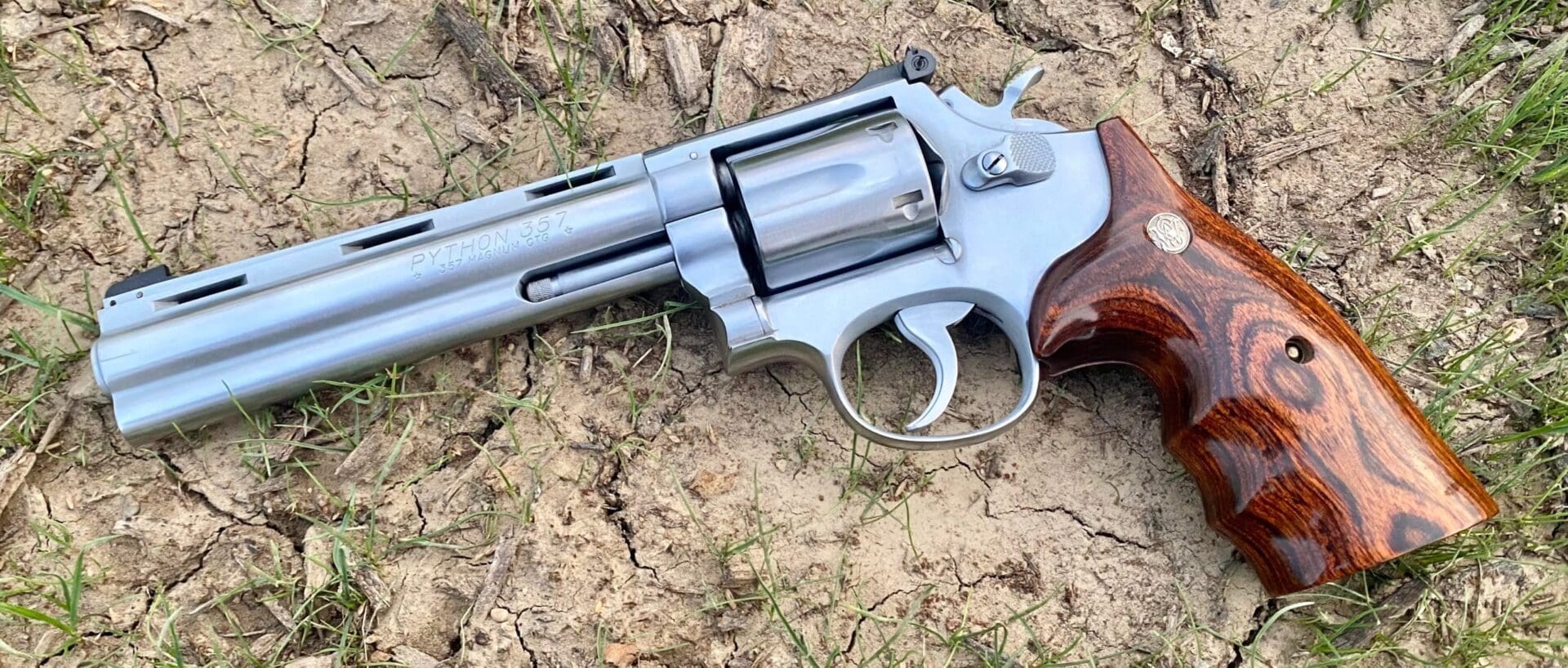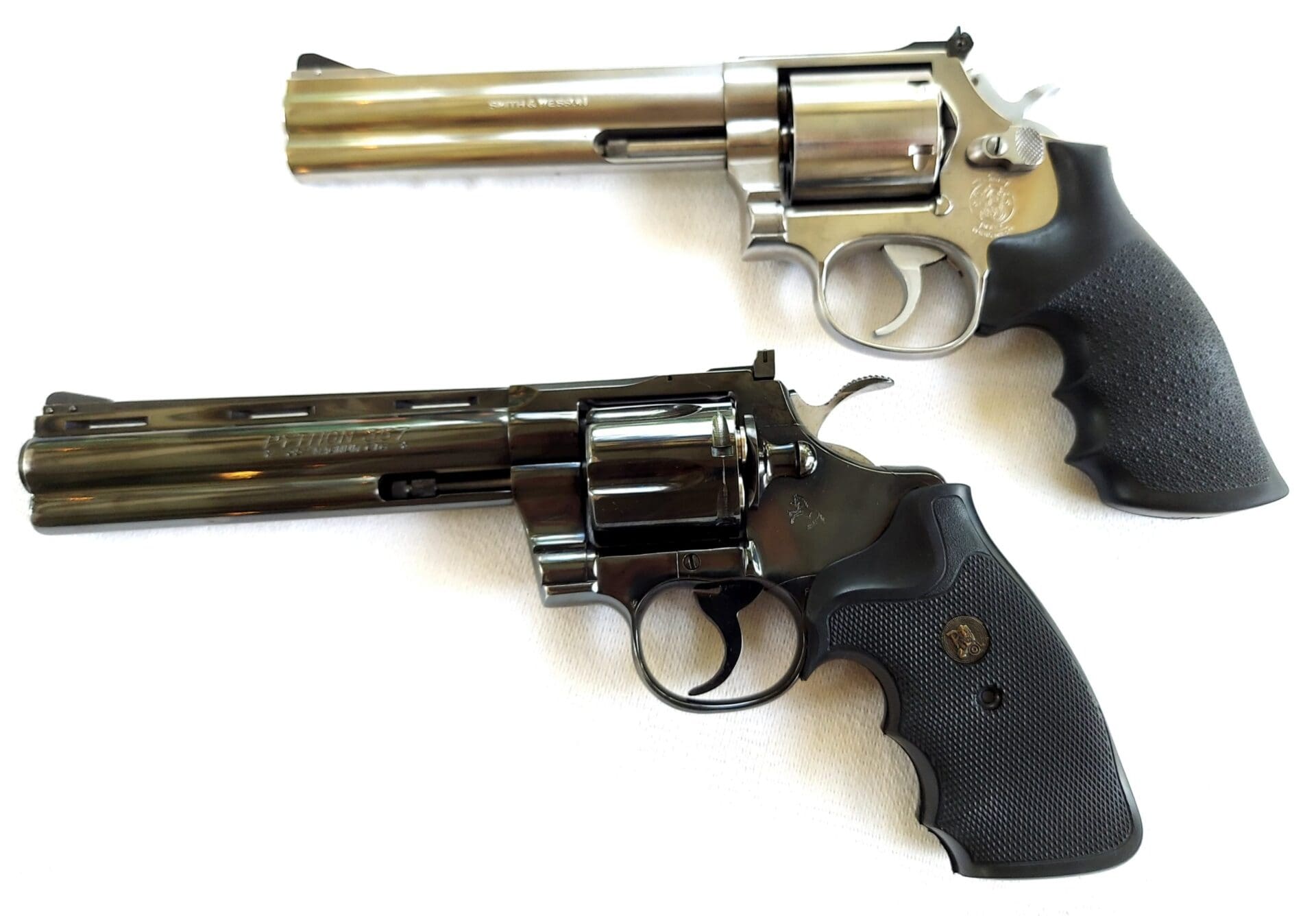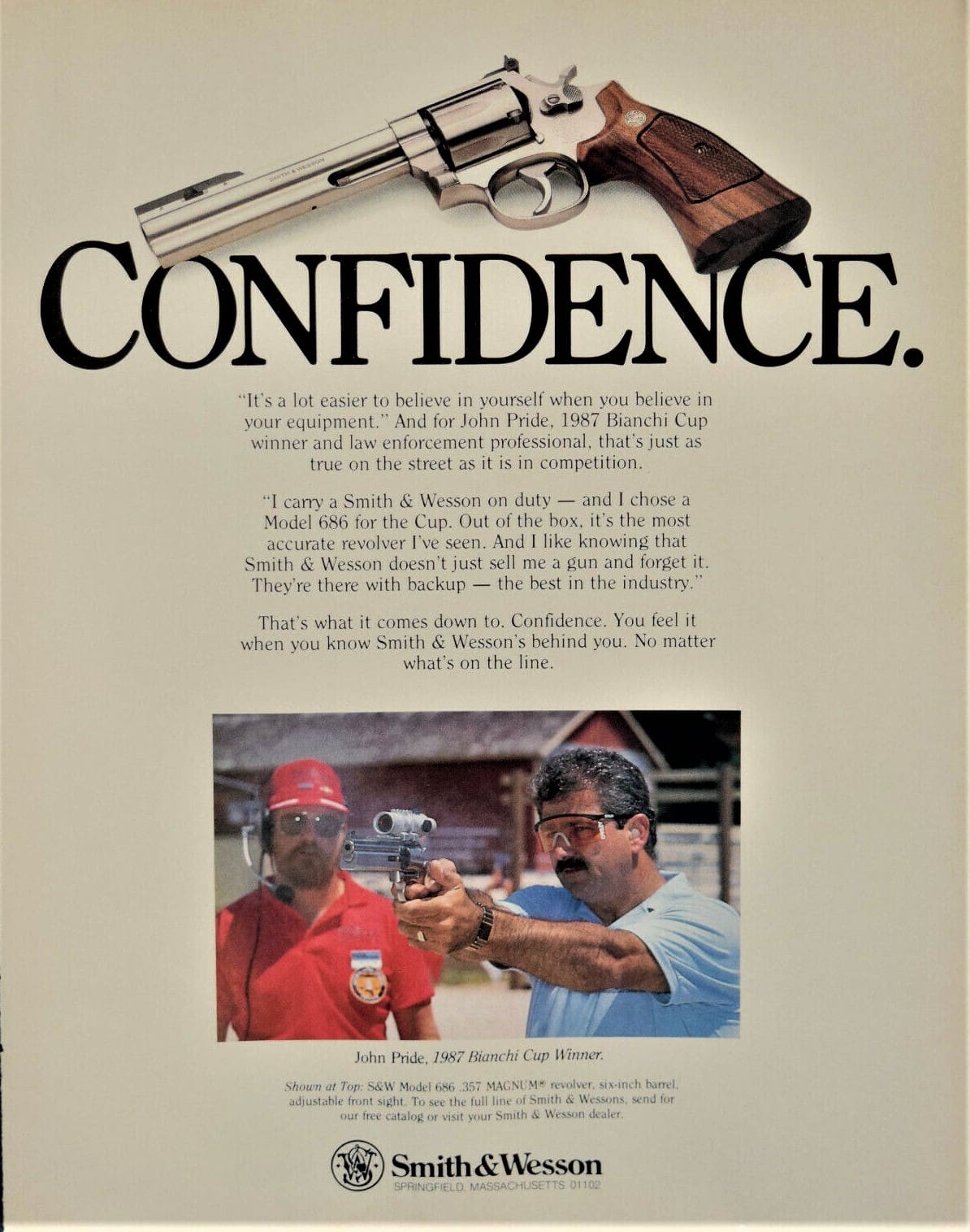Two classics going head to head. Yes, I know, the Colt Python and the Smith & Wesson Model 686 have been compared ad nauseam, especially since the Python was reborn. This is slightly different since both guns are originals; the Colt was made in 1978 and the S&W was made in 1988. I am not comparing the current production guns here.
Why? Because to me, the current production guns from Big Blue are a knockoff of the originals. The current production 686s come with metal injection molded parts, two-piece barrels, frame-mounted firing pins, and the dreaded lock.
The current snake gun from the Prancing Pony isn’t really the same either. The current Pythons have up to thirty different parts that are different compared to the originals which resulted in different lock work. And the frame is stainless steel. Get off of my lawn.
Anyway, on to the main event . . .

The Colt Python, often considered the Cadillac of revolvers (back when that was a real compliment) was introduced by the Prancing Pony in the 1950s as their flagship wheel gun for the post-war premium handgun market.
Colt took everything they learned from their pre-war guns like their I-Frame Model .357 Magnum and their Officers Model (Match, Target & Special) and rolled it into one platform.

The first prototypes had half-lugged barrels, but Colt decided to go with a vent ribbed full underlug barrel for better balance and to give it a striking visual cue that made the Python an easily recognizable gun on any firing line. Its accuracy and smooth trigger was renowned.
A gun known for quality, Colt went so far as laser bore sighting the Pythons during assembly to ensure accuracy in the 1970s. That was a first in the industry according to Great Combat Handguns: A Guide to Using, Collecting and Training With Handguns.
A number of agencies issued the Python even though it was a high-priced gun. The Florida Highway Patrol, Georgia State Patrol, and Colorado State Patrol issued the snake gun and their officers loved ’em. Many other cops across the country purchased the Python privately and carried them when allowed.

Smith & Wesson, long in the .357 Magnum premium handgun game, since they started it in 1935 with their Registered Magnum. But from then until 1980, Smith only made their original large N-Frame guns and medium-sized K-frames.
The K-frame .357 Magnum was a 1950s cop’s dream, designed by the legendary lawman himself, Bill Jordan. But the K-frames had a minor issue. A steady diet of .357 Magnum ammo would eventually crack the forcing cone in the barrel and render the gun useless.
Back then, that wasn’t much of an issue since the mindset at the time was practice and qualify with .38 Special and carry .357 Magnum on duty. With a change in training tactics and the use of duty ammo during training, the K-Frames were being worn out.
The answer was something in between the N-frame and K-frame. Big Blue gave us the L-frame in the form of the Model 586 (blued) and the Model 686 (stainless).
The Model 686 was an instant hit. Having a beefier frame than the K-frame guns, but still using the K-frame grip, it was the perfect duty gun from S&W. Agencies all over flocked to the Model 686, especially since it was priced lower than the Python.
The U.S. Border Patrol, Immigration & Naturalization Service and the U.S. Customs Service all issued them. The U.S. Customs Service went so far as to have a special variant made for them and even the U.S. Navy SEALs used them for a period of time.
Additionally, the Model 686 was Smith & Wesson’s direct competitor to the Colt’s Python. The full underlug on the barrel is there for a reason…it was to appeal to shooters who liked it on the Colt. Prior to the introduction of the Model 686, shooters would take Python barrels and have gunsmiths install them on S&W frames, making the “Smolt” revolver.

All in all, the Model 686 was a hit and has been in production ever since. You’re probably aware of the Python’s different production history. While slightly different, it’s nice to have it back.

As mentioned, the Colt in this article was made in 1978 and is a gem of a gun. Everything is still remarkably tight on the gun. The factory wood grips have been replaced with a pair of Pachmayr Gripper grips. Why? Because wood might look nice, but rubber does a better job for guns that are being shot.
The Model 686 is a “-3” model. It’s the third variant in the design with some upgrades and changes to the original design. This one is special. It is part of Smith’s Classic Hunter line made for Lew Horton Distributing. Only 5,000 of them were made in 1988. The gun came from the factory wearing Hogue Monogrip and an unfluted cylinder.

Both guns have adjustable rear sights. The Model 686 has a serrated top strap and barrel while the Python has a bead blasted finish. Both are there to reduce glare for the shooter. They just do it in different ways.

Both have white outlined fully adjustable rear sights.

The front sight on the Model 686 has a single pin holding it in place while the Python has two. As mentioned, both have full underlug barrel.

An easy identifier many people use to distinguish the two guns at a glance are the characteristic cylinder release latches. The Python’s works by pulling it back while the Model 686 works by pushing it forward.
But let’s shoot these two . . .


As you can see, the Python has a slight advantage. Again, there’s a reason why folks used to take Python barrels and slap them on Smith frames. Those barrels were known for their accuracy and that is part of what made the Python such a great shooter.
Trigger-wise, the Colt uses a “V” mainspring rather than a flat mainspring (though the “V” shaped spring happens to be flat). Because of this, the Colt is long action and S&W has a short action design. All things being equal, the Colt’s long action double action pull will feel lighter through the longer arc since there is more leverage.
The Colt has an eight-pound double-action pull. The single action pull comes in at about three pounds while the 686 is 10 pounds in double action and the single action pull is about 2.5 pounds.
One issue the Python was known for was relatively delicate lockwork. If a Python was put through heavy use, they were known to go “out of time.” The cylinder wouldn’t exactly lineup with the barrel’s forcing cone and the fired round would actually be “shaved” sending lead into the shooter’s hand.
The Model 686, using the same lockwork as the N, K, and J frame guns, was a tough and reliable design that could take a licking and keep on ticking.
In the end, as a huge fan of both revolvers, I’d have to give a slight advantage to the Model 686 for its stronger lockwork. Yes, the Colt has better accuracy, but it isn’t very much of a difference and if I sit down and actually sight in the gun properly to that specific load, I get truly excellent results out of the 686.
If you’re looking for an investment, the Colt retains its value. I think the current production guns are better for the shooter since they have a more updated lockwork. But the original guns are classics.

If you’re looking for a shooter, get the Smith. But be forewarned…the prices on pre-lock guns are only going in one direction and it isn’t down.

I’m happy to have both and here’s the kicker. From what I can recall, I paid $300 for the 686 and $600 for the Python. That wasn’t in the last century, it was in the 2010s. I just happened to be in the right places at the right times.
Luis Valdes is the Florida Director for Gun Owners of America.





Theres a lot of nostalgia around classic revolvers, but I disagree with the points made on the modern S&W’s as some how inferior. On the lock, I can take them or leave them. While Id prefer them without, Ive never had an issue with them from the dozens of models I’ve had, though I have hewrd of the issues with the superlight ones. S&W would undoubtedly increase sales by removing them. However, I see the other issues mentioned, like the MIM parts and two peice barrels, as a net positive for the modern shooter. As someone who has broken hammer mounted firing pins, I will take the frame mounted pins any day. As an actual shooter, the availability of replacement and aftermarket parts is important. The older prices are becoming more collectors pieces, I would much rather have something I can shoot heavily and not worry about decreasing its value by putting wear on it.
I agree with your thoughts on the newer models. Just over 2 years ago there was a post on TTAG where a guy took his 686 and removed an 8″ barrel and installed a 4″. And then he could change it over again and all the configurations it shot well.
I have the 686-6 plus with the 6″ barrel and I love it. Nice balance and when firing 357 the recoil is not much more than the 38. Very minimal. I got it as all my other pistols are semi’s and I figured it was time for a wheel gun. It was a good decision and I am looking at other types as a possible addition to the family.
I’d take a gun without the Hillary Hole, that said I don’t seem to have any beef with MIM parts at the moment. My 66-5 seems to work just fine and be plenty smooth at that.
“Right place right time” is important when buying used guns. I picked up my 1984 manufactured Ruger Security Six for $315 within the last five years.
The Security Six isn’t fancy like the Python, but it an awesome mid sized .357 mag revolver. It scratches my itch for a “duty revolver”.
Whenever there is an article about the 686, Python, or GP100, someone has to jump in and mention the older Ruger “Security/Service/Speed Sixes”.
🙂
What’s wrong with injection molded steel? It lowers the cost of production, making it cheaper for the public, and is just as strong as forged steel. I’ll take a Ruger over an old Python, or a new one for that matter, any day of the week. For reliability especially. Ditto for S&W.
MIM is different than casting, which Ruger uses for its frames. Casting vs. forging vs. machined bullet is a whole other story. MIM is powdered metal with binders that gets molded, the binders burned out, and then the remaining metal sintered. MIM isn’t intended to be machined. Badly made MIM won’t have thick enough surface hardening for stoning, be too soft to not wear, be too brittle and crack, etc. Getting all the variables right takes development time some companies didn’t invest in, and their poor results gave MIM a bad name.
Smith makes really good MIM parts. But, if you manage to break one or if you really must have all forged steel parts, you can get them from the aftermarket. Most of the internal parts are the same up & down the line, except for the J frames, and the dimensions & fitting procedures are well known.
I would prefer no-lock versions, but I won’t let that keep me away from an otherwise well-made gun. And by now, the no-lock ones are well on their way to being collector’s pieces, with prices to match.
Re; split forcing cone; I bought a 6″ Python used from a cop in 1970 to replace my 4″ which was stolen. After shooting for a while I discovered the forcing cone was split, I imagine it was split when I got it (I hadn’t had it long). Far from being “rendered useless, I mailed it back to Colt and spent $40 for a new 4″ bbl and refinish/checkup. Shot hell out of that gun, until eventually it needed another bbl 30-odd years later. I had been hoarding a NIB 4” for 30 years by then (cost me $160 at a Gibson’s circa 1972), so I took the old one to a gun show and sold it for 4X what I paid for it, including the rebarrel. I would love to also have a mint Model 19, but the imitations being sold now don’t do it for me.
Gibson’s. That brings back some memories.
Gibson’s was a Texas chain of discount department stores that were ubiquitous in small Texas towns long ago (along with Western Auto, Woolworths, etc.). When I was a kid that’s where I’d go to buy boxes of .22, 30.06, 12 and 20 gauge shotgun shells, etc.
Walmart pretty much killed Gibson’s. There was one in Kerrville a few years ago, but I haven’t seen any others in years.
One of my earliest gun memories was seeing 50 round boxes of .22lr on the counter next to the register at the local corner store, for 25 cents.
One-half of one penny a round for ammo…
Was that back when quarters were made of 90% silver (1964 and earlier)? They kept value of a silver quarter is over $5 today. That would be equivalent to 10¢ a round.
They dollar has gone to crap since we separated it from gold and silver.
don’t have the time to read the whole article right now, and I’m still a relative newcomer to guns. What the flying farts is a Hillary Hole?
Internal lock on S&W revolvers that is almost universally reviled. I believe they were implemented during the Clinton Administration, hence the Hilary connection.
It was part of an agreement between the Clinton administration and S&W that would exempt S&W from some proposed ideas the anti’s wanted at the time. Mostly a sell-out on S&W’s part, somewhat akin to the horseshit that Springfield and Rock River pulled on the citizens of Illinois.
https://www.youtube.com/watch?v=Tv8fP15dN0E
Note: No flag on the hammerless (concealed hammer) models, such as the J frame 642.
Frankly, the Hillary hole doesn’t particularly bother me, though I would have purchased a 642 without, if one had been available. On the other hand, S&W did offer some models without an internal lock, when I was shopping for a pocket rocket. But, I can’t remember which ones now.
Anyway, the internal lock can be removed, if the user so desires. And there are after-market plugs available to fill the hole.
Rugers are stronger and more durable than S&W or Colt. S&W, imho, has the smoothest action right out of the box. Some of my best shooting has been done with K frame smiths in .38 special. More accurate than I am.
I had 2 Colts that I regret giving up. A Dick’s special with the unshrouded ejector and a 1903 in .32 acp. That 1903 was as snag free as any non custom gun could be.
I love my Ruger Security Six. Once upon a time, I also had a WWI era Colt 1917 New Service revolver in .45ACP. Sadly, I sold it during a period of financial hardship. It had been refinished before I ever bought it so it wasn’t that collectible (hence the reason I would buy it).
It is a little sad that I don’t have it anymore, but the 1917 is a little big and heavy for a six shot .45acp. My Security Six is smaller, lighter, stronger,.and fires a more potent round.
I like collecting guns, but I’m not a “true collector”.
Both gunms are a hard choice but I’d pick the python.
A python would eat a possum.
Damn never thought about that.
“A python would eat a possum.”
All the more reason to keep a lady Possum around with a Colt in her pouch… 😉
How’s a possum supposed to fit a baby horse in its pouch?
586/686 all day for me but I wouldn’t feel bad with a python
I have a 686 I purchased in 1987 and swore I would NEVER sell. Paid $285.00 at a kitchen-table FFL.
Sweet shooter. Shooting from a rest I put six rounds of full-power .357 HOT reloads in a single hole Just low and right of the X at 10 yards from a rest. Best group I have EVER shot and I blame it all on the gun.
A Smolt is better than either one in my opinion. I had a pre-lock 686 that had to go back twice as the barrel unscrewed. Promptly sold it and I will only buy P&R N frames. Never was impressed by snake guns more of a show horse than a work horse.
Both are great wheelguns. But also see the Monson-made Dan Wesson pistol packs (1970’s-early ‘80’s).
Especially in .41 magnum.
I don’t think either one is necessarily “better”. My Python is an 8″ blue example that I purchased new in ’81 for just a tick over $400. It’s an awesome shooter. Almost unfair. I also have it’s brother, a Trooper MK III, also 8″ blue made in ’78. Another very accurate shooter.
I love my S&Ws just as much. Never bought an L frame (yet), but have P&R Ks and Ns and a few Js. All great guns in their own right.
To me, it’s like arguing Ford vs Chevy. Which one is better?
Ford 1911A1
Toyota.
Late-80s Japanese cars are about as good as it gets…
There is no such thing as a prewar I-frame .357. Only pre-WWII Colt .357s are the New Service and SAA, and there aren’t many of either.
“But from then until 1980, Smith only made their original large N-Frame guns and medium-sized K-frames.”
I guess I’ll throw out all my J-frames then. There’s also the S&W I-frame and the tiny M-frame.
This is the best blog so far
Comments are closed.